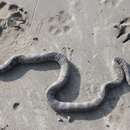en
names in breadcrumbs


Leviton et al. (2003) provide a technical description of this dangerously venomous snake: Scales on thickest part of body quadrangular or hexagonal in shape, feebly imbricate or juxtaposed. 14-18 maxillary teeth behind front fangs; 2 anterior temporals. Scales in 31-43 rows on the neck, 38-54 around midbody (increase from neck to midbody 6-14); ventrals 253-334, distinct throughout though not twice as large as adjacent body scales; bluish gray above, whitish below, with 40-60 broad bands, about twice as wide as interspaces, tapering ventrally (in older adults, bands become indistinct).
According to Leviton et al. (2003), Hydrophis caerulescens occurs in Myanmar [Myanmar]coastal waters, where it is especially abundant in the Mergui Archipelago (Tanintharyi Division). This species also occurs on both the west and east coasts of India (vicinity of Bombay and Karwar in the west and from Madras to the mouth of the Ganges on the east coast) east through Straits of Malacca to the Gulf of Siam [=Gulf of Thailand] to southeastern China and western Indonesia. The habitat has not been described (Leviton et al. 2003).According to Kharin (2004), this species is found along the eastern coast of India, coastal areas of Ceylon [Sri Lanka] and Burma [Myanmar], the Straits of Malacca, the Gulfs of Thailand and Tonkin, the Yellow Sea, coastal areas of Java and Kalimantan, and the Gulf of Carpentaria.
This species was referred to the new genus Polyodontognathus by Kharin (2004).